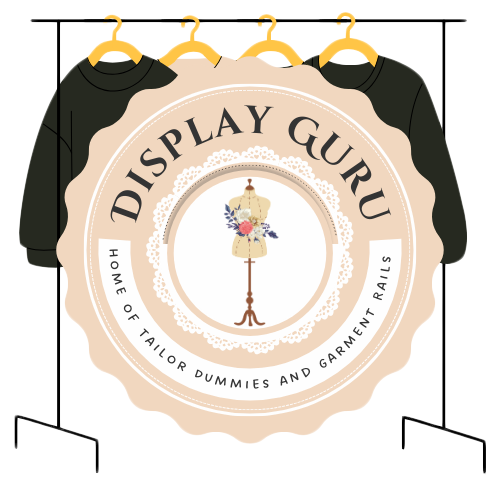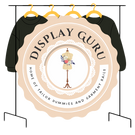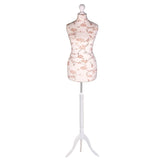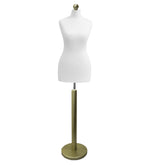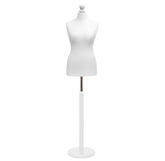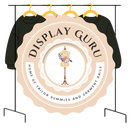Dressmaking Forms Adjustable: The Ultimate Fit Guide
Picture this: a perfect stand-in for your body, ready and waiting 24/7, helping you create clothes that fit like a dream. That's the real magic of getting your hands on dressmaking forms adjustable to your own unique shape. These aren't just display mannequins; they're essential tools that close that frustrating gap between a standard sewing pattern and your actual body.
Why a Dress Form Is Your Secret Sewing Weapon
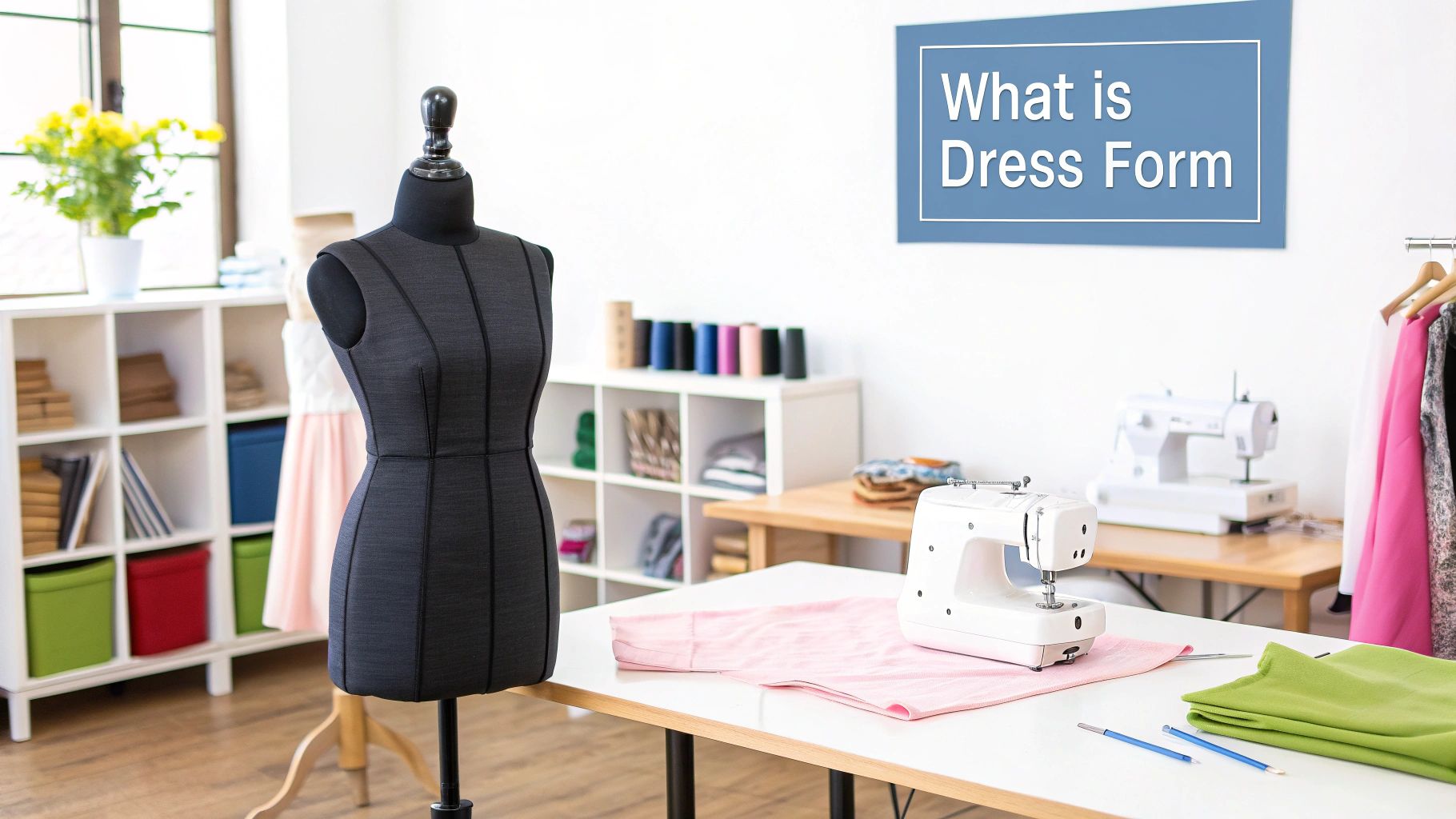
If you're serious about sewing, you know the biggest hurdle is often getting the fit just right. Patterns are drafted for a "standard" figure that, let's be honest, hardly ever matches up with real people. This is where the struggle usually starts—awkwardly pinning fabric on yourself while twisting in front of a mirror, or taking a garment on and off a dozen times for tiny changes. It's a process that’s often full of guesswork and can frankly be quite maddening.
An adjustable dress form is your patient, silent fit model. It lets you see precisely how a garment will hang and drape on a three-dimensional body, a perspective a flat pattern on a table can never offer. You can drape fabric, pin your seams, and check the fall of a skirt with an accuracy and ease that’s impossible on your own.
More Than Just a Mannequin
It’s easy to think of a dress form as a luxury, something you’d only find in a professional designer's studio. The reality is, it's a vital partner for anyone who wants to achieve that polished, tailor-made look. Being able to dial in the form to your specific measurements takes so much of the trial-and-error out of home sewing.
This becomes especially important when you’re working with tricky or expensive fabrics, where a mistake can be heartbreaking (and costly). Imagine tailoring a wool blazer or fitting a delicate silk blouse. You can perfect the entire silhouette on the form before a single permanent stitch goes into your beautiful fabric.
An adjustable form changes the fitting process from a solo struggle into a creative dialogue. It allows you to step back and play the role of the designer, analysing proportions, style lines, and drape from a clear, objective viewpoint.
A Foundation for Better Sewing
Using a dress form doesn't just improve fit; it actively builds your skills and confidence. It gives you a stable base for practising advanced techniques that are incredibly difficult, if not impossible, to tackle when fitting on yourself.
These skills include:
- Accurate Draping: This is the art of creating patterns by manipulating fabric directly on the form, a cornerstone of custom design.
- Precise Alterations: You can easily see exactly where a garment needs to be taken in or let out, ensuring the final result is perfectly symmetrical and balanced.
- Ergonomic Work: It saves your back and shoulders from all the twisting and contorting that comes with self-fitting.
Ultimately, investing in dressmaking forms adjustable to your measurements is an investment in your craft. It saves time, reduces wasted fabric, and, most importantly, empowers you to create clothes that don’t just look handmade, but feel truly bespoke. It’s the key to unlocking a whole new level of precision and enjoyment in your sewing journey.
What Makes a Great Dress Form?
When you first start looking for an adjustable dress form, it’s easy to feel a bit lost. The market is flooded with options, all boasting different features and technical specs. But not all forms are created equal. To find one that’s a true partner in your sewing room, you need to understand what separates a genuinely useful tool from a glorified mannequin.
Think of it like buying a car; you wouldn't just look at the paint colour, you'd want to know what's under the bonnet. The same principle applies here. Key features like the adjustment dials, the stability of the stand, and even the material on the surface can make or break your sewing experience and the final fit of your garments. A great form isn't just a body shape; it's a precision instrument.
The Adjustment System Itself
The heart of any adjustable dress form is, of course, its adjustment system—usually a set of dials or keys that let you expand and contract the body. But the real difference between a basic model and a truly versatile one lies in how many dials there are and where they're placed.
Most standard forms will give you dials for the three main measurements:
- Bust: To adjust the circumference around the fullest part of the chest.
- Waist: To set the narrowest point of the torso.
- Hips: To expand or contract around the widest part of the lower body.
A quality form, however, will typically offer 12 or more adjustment points. This is crucial because it allows for far more nuanced, realistic shaping. After all, very few human bodies are perfectly symmetrical. With more dials, you can make one hip slightly larger than the other or adjust the upper chest independently of the full bust, mirroring real-life figures.
One of the most important—and often overlooked—adjustments is the back waist length. This measurement, running from the base of the neck to the natural waistline, varies hugely from person to person. A form that lets you lengthen or shorten the torso is invaluable for stopping garments from bunching up or pulling in all the wrong places.
Stability and Mobility: The Stand
The stand does more than just hold the form upright; it needs to be a stable foundation for all your draping, pinning, and fitting work. There’s nothing more frustrating than a form that wobbles every time you touch it. You’ll generally find two main types of bases.
A tripod base is a classic for a reason. It distributes the weight across three points, making it incredibly stable and less likely to tip over, even when you're wrestling with heavy fabrics. In contrast, a pedestal or round base can look sleeker and be a bit easier to manoeuvre in a tight space, but it might not be quite as steady unless it's very heavily weighted. For the best of both worlds, many professional-grade forms come with locking castor wheels, so you can easily wheel your form around the room and then lock it firmly in place.
Pinnable Surfaces and Other Clever Features
The surface of the dress form is another make-or-break feature. Cheaper models often have a hard plastic shell with just a thin fabric cover. With these, you can only slide pins in at an angle, finding the gaps between the plastic panels, which is incredibly restrictive.
A fully pinnable form is a game-changer. These forms have a softer core—often made from dense foam or traditional papier-mâché—underneath the cover. This means you can stick pins straight into the body, anywhere you need to. For professional draping and precise pattern making, this isn't just a nice-to-have; it's essential for creative freedom.
Some high-end adjustable dressmaking forms come with even more specialised features designed for complex projects:
- Collapsible Shoulders: A clever mechanism that lets you compress the shoulder area, making it a breeze to get tight-fitting tops and dresses on and off the form without stretching the neckline.
- Split-Hem or Bifurcated Models: These forms have separate legs, making them indispensable for getting a perfect fit on trousers, shorts, and jumpsuits.
These advanced features are particularly prized in the UK's bespoke clothing sector. While the wider clothing industry changes, the demand for custom tailoring and its focus on a perfect fit remains strong. Tools like these support that dedication to precision, which also helps reduce fabric waste and encourages a more sustainable approach to fashion. If you're interested in the broader industry context, you can find out more about the UK's clothing manufacturing landscape from IBISWorld.
By getting to grips with these features, you can choose a form that won’t just meet your current needs, but will be a reliable tool that grows with your skills for years to come.
How to Choose the Right Adjustable Form
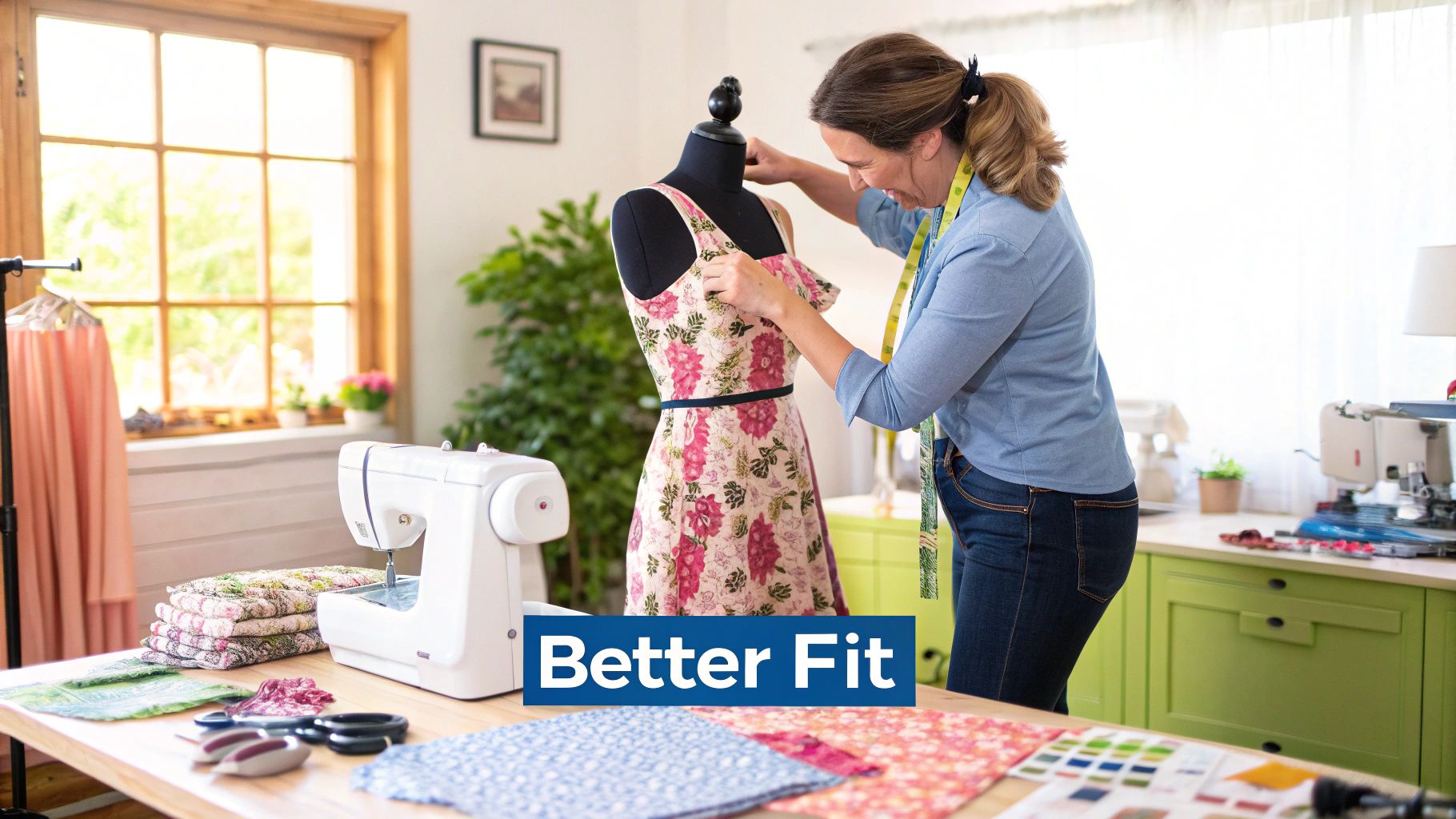
Finding the perfect adjustable form is a lot like finding the perfect pair of jeans. There’s no single "best" option out there; the right choice is deeply personal and depends entirely on your sewing ambitions, the kinds of projects you dream of making, and how you’ll use it day-to-day.
Think of it less as buying a product and more as hiring an assistant. You need to match its skills to your creative needs. The first step is to be honest about what kind of sewer you are. Are you a passionate hobbyist who loves making clothes for yourself, or are you an aspiring designer with plans to launch a collection? Your answer will lead you down very different paths when it comes to dressmaking forms adjustable to your goals.
For the Passionate Home Sewer
If sewing is your creative escape and you primarily make clothes for yourself or your family, your main concerns will be versatility, ease of use, and getting good value for your money. You’re looking for a reliable partner in your craft room, not necessarily an industrial-strength workhorse.
For most home sewers, a classic dial-adjustable form is the perfect starting point. These models hit that sweet spot between features and affordability, typically offering between 8 to 12 adjustment points for the bust, waist, and hips. This is more than enough to create a close approximation of your own body for fitting most garments. Just make sure it comes with a sturdy tripod stand for stability while you’re pinning and adjusting.
The golden rule when buying your first form is this: choose one based on your smallest measurement. A form can only get bigger from its starting size. It's always better to get a slightly smaller model and pad it out to match your unique curves than to buy one that's too large to ever dial down to your actual size.
For the Aspiring Designer and Small Business Owner
The moment sewing shifts from a hobby to a business, your needs change dramatically. Durability and professional-grade features suddenly become non-negotiable. Your dress form is no longer just a fitting aid; it’s a critical piece of equipment that has to withstand constant, heavy use.
At this level, you should be looking at professional-grade forms. They're built from more robust materials and come with features specifically designed to speed up your workflow and improve your precision.
- Collapsible Shoulders: Honestly, this is a game-changer for anyone making closely-fitted garments. It lets you slip tight bodices on and off with ease, preventing any stretching or damage to your hard work.
- Fully Pinnable Body: Unlike standard forms where you have to pin at an angle into a thin cover, a professional form has a solid, dense core. This means you can stick pins straight in, anywhere on the torso, which is absolutely essential for serious draping and patternmaking.
- Heavy-Duty Stand with Wheels: A solid metal base with lockable castors gives you the best of both worlds: rock-solid stability when you need it and effortless mobility to move the form around your studio.
Choosing a Form for Specialised Projects
Your area of sewing specialism should also play a big part in your decision. After all, not all projects are simple skirts and blouses. If your passion is in a more niche area, you’ll be far better off with a form designed specifically for that purpose.
For example, if you create stunning bridal or evening wear, you’ll be working with heavy, layered fabrics that can weigh a lot. You need an exceptionally sturdy form that won’t wobble or lean under the strain. Likewise, if you’re into historical costuming with its corsetry and unique silhouettes, you'll need a form that can be padded and shaped in all sorts of unconventional ways.
To help you see how these different options stack up, here’s a quick comparison of what’s available on the UK market.
Adjustable Dressmaking Form Comparison
This table breaks down the common types of adjustable forms to help you match their features to your specific sewing needs and budget.
| Form Type | Key Features | Best For | Approximate Price Range |
|---|---|---|---|
| Dial-Adjustable | 8-12 dials, lightweight, fabric cover over plastic. | Hobbyists, beginners, personal garment fitting. | £100 - £200 |
| Professional Form | Fully pinnable, collapsible shoulders, heavy-duty base. | Designers, students, small business owners. | £300 - £700+ |
| Bifurcated (Legs) | Split legs, allows for fitting trousers and jumpsuits. | Tailors specialising in menswear or trousers. | £250 - £600 |
Ultimately, choosing the right form comes down to a clear understanding of your own work. By thinking about whether you need it for personal projects, professional use, or a specialised craft, you can invest wisely in a tool that will support your creativity for years to come.
For a more detailed walkthrough on getting that perfect fit, you might want to check out our adjustable mannequin for sewing ultimate fitting guide.
Creating Your Body Double: A Step-by-Step Guide
Unboxing your new adjustable dressmaking form is a brilliant moment, but it's only the beginning. The real magic happens when you transform that generic mannequin shape into a precise replica of your body—a true body double. This process is less about randomly twisting dials and more about systematically building a shape that mirrors your unique posture and proportions.
The journey starts not with the form, but with you. Before you even think about touching a dial, you need a crystal-clear picture of the body it’s meant to replicate. That means taking a comprehensive set of your own body measurements. Getting this right is the foundation for everything that follows; even the best form is no use if you're working with the wrong numbers. Our complete guide on how to take body measurements for clothes can walk you through getting this part perfect. With those vital stats in hand, you're ready to start.
Transferring Your Measurements to the Form
First things first, let's set the height. Most dress forms have a locking mechanism on the stand that lets you raise or lower the torso. Your aim here is to match the form’s shoulder height to your own. Once that's set, it's time to tackle the main circumference dials for the bust, waist, and hips.
Turn the dials slowly and incrementally, checking your progress with a tape measure as you go. It's crucial to expand the form evenly. If you just crank the front bust dial all the way out without touching the back, you’ll end up with a distorted, unrealistic shape. The trick is to give each dial a few turns at a time, working your way around the form to keep the expansion balanced and symmetrical.
A common mistake is to adjust the dials to their maximum right away. This can put a lot of stress on the internal mechanism and may even warp the form's posture over time. Always work gradually, building out the shape little by little until you reach your target measurements.
This simple graphic shows the core adjustment sequence for any standard dial-based form.
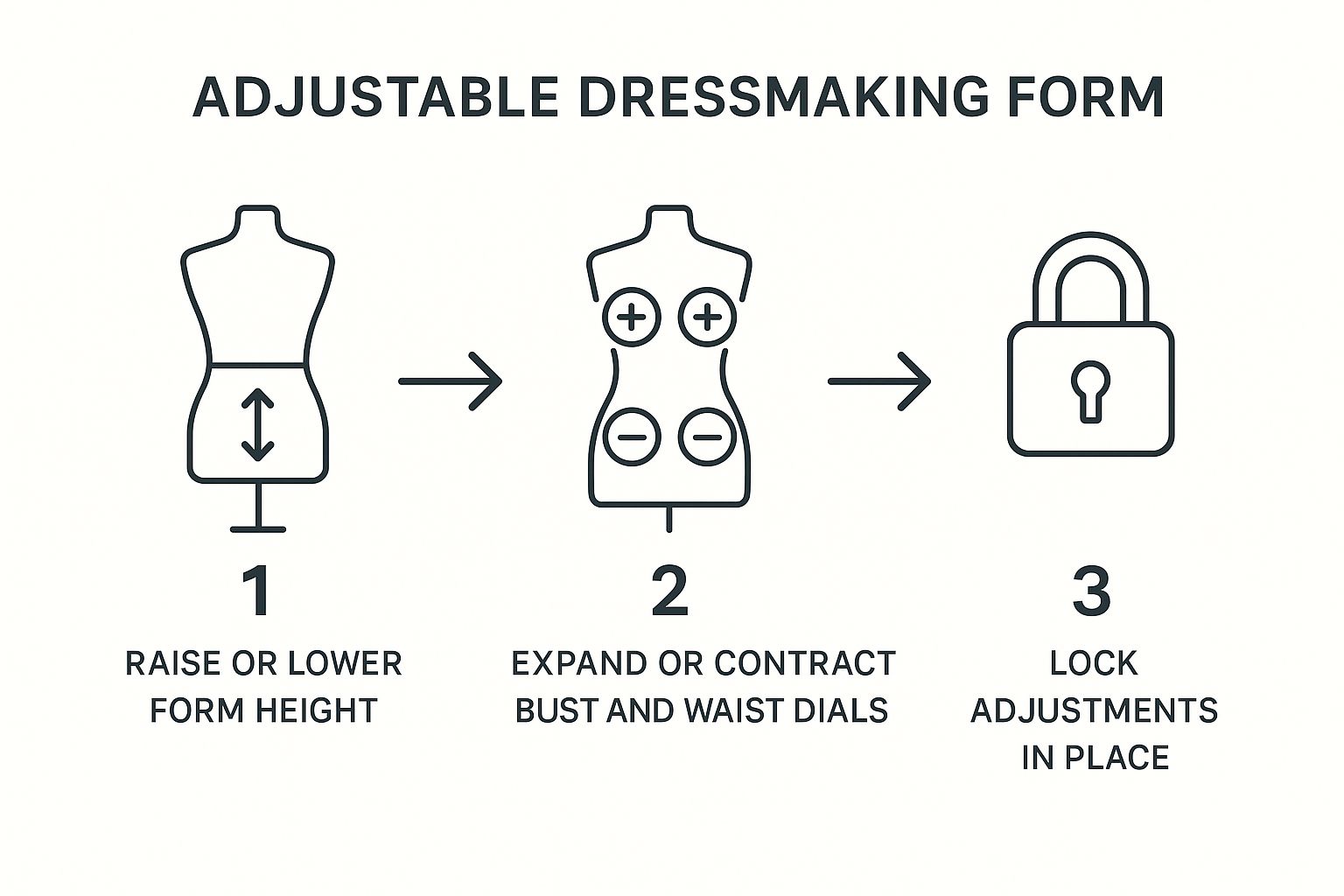
As you can see, the process flows from setting the height to expanding the core measurements before locking everything in place. This ensures you have a stable foundation for your work.
The Art of Padding for a Perfect Fit
Dial adjustments will get you about 80% of the way there—they create the basic silhouette. But it’s the final 20% that really counts. This is where you capture your individual nuances, like a rounded tummy, a sway back, or fuller hips. This is achieved through padding, and it's how your form truly becomes your form.
You'll need a few key supplies for this stage:
- Polyester Wadding: This is the ideal material for building up shape. It’s lightweight, easy to layer, and can be sculpted into place.
- Pins: You'll need plenty of pins to hold the wadding in place as you shape it.
- A Padded Form Cover: A stretchy, fitted cover is non-negotiable. It pulls everything together, smoothing out the lumps and bumps of the wadding to create a single, pinnable surface.
Start by identifying the areas where the form’s shape differs from your own body. This could be anywhere—the upper bust, the curve of your back, or the top of your thighs. Cut pieces of wadding and begin layering them onto these areas, pinning them securely as you build up the volume.
Keep checking the measurements with your tape measure. Add or remove layers of wadding until the padded form perfectly matches your body's contours and circumferences. Once you're happy, carefully pull the padded cover over the entire form. This final step compresses the wadding and creates a smooth, professional finish, ready for you to drape, fit, and design your next masterpiece.
The Real Benefits of Using an Adjustable Form
An adjustable dress form does far more than just help you get a better fit; it can genuinely transform your entire sewing process. It’s not just about accuracy, although that’s a huge plus. Think of it as a strategic investment that brings a new level of efficiency and creativity to your work. It's your silent partner, always there to help bring your designs to life.
The most immediate win? The sheer amount of time you’ll get back. Wave goodbye to those frustrating self-fitting sessions, twisting and turning in front of a mirror, trying to pin a straight seam on your own back. An adjustable form makes that whole cycle obsolete, letting you make precise changes in a fraction of the time.
Unleash Your Creative Potential
One of the most exciting things about having a form is how it becomes a 3D canvas for your imagination. It gives you the freedom to properly experiment with draping—the art of designing directly with fabric on the form itself. You can see exactly how different materials fall and hang, play with new style lines, and draft patterns that are genuinely one-of-a-kind. It’s a hands-on approach that’s almost impossible to replicate on a flat table or on your own body, and it builds a much deeper understanding of how fabric behaves.
This kind of creative freedom is a huge advantage in today's clothing market. The UK apparel sector is projected to hit £85.85 billion in revenue, and much of that is driven by a desire for customisation and made-to-measure clothing. People want unique pieces that fit them perfectly, a demand that tools like dressmaking forms adjustable to specific bodies help both professionals and hobbyists meet. You can read more about this in the latest UK fashion industry statistics from Spring Fair.
A dress form turns fitting from a chore into a creative conversation. It lets you step back and assess your work like an artist, objectively analysing silhouette, proportion, and balance without the awkwardness of self-fitting.
This is particularly crucial when you’re sewing for different body shapes. If you create garments for others, including those needing plus-size options, a form is an indispensable tool for achieving an inclusive, flattering fit. You can find out more on this in our article about using plus-size mannequins for stylish and inclusive displays.
Prioritise Comfort and Sustainability
Beyond the creative perks, there are some serious ergonomic benefits. Working on a stationary form, set to a comfortable height, saves your back, neck, and shoulders from the strain of contorting yourself to pin and adjust. This simple change can make your sewing sessions so much more enjoyable and, frankly, sustainable for your body in the long run.
Speaking of sustainability, an adjustable form is a fantastic tool for any mindful maker. It helps you dramatically reduce fabric waste by letting you perfect the fit on a toile or mock-up before you even touch your expensive final fabric. Getting it right the first time leads to higher-quality, better-fitting clothes that are far more likely to be worn and loved for years—a perfect match for the principles of slow fashion.
Here’s a quick summary of the key advantages:
- Improved Efficiency: Dramatically cuts down on fitting time and fiddly self-adjustments.
- Enhanced Creativity: Provides a 3D canvas for draping and designing unique garments.
- Better Ergonomics: Prevents the physical strain that often comes with self-fitting.
- Reduced Waste: Minimises fabric consumption by perfecting the fit before you cut your final material.
- Professional Results: Helps you achieve that polished, bespoke finish on every single project.
Ultimately, an adjustable dressmaking form is so much more than a simple mannequin. It’s an essential piece of equipment that elevates your craft, boosts your confidence, and empowers you to create with greater precision and joy.
Common Mistakes and How to Avoid Them
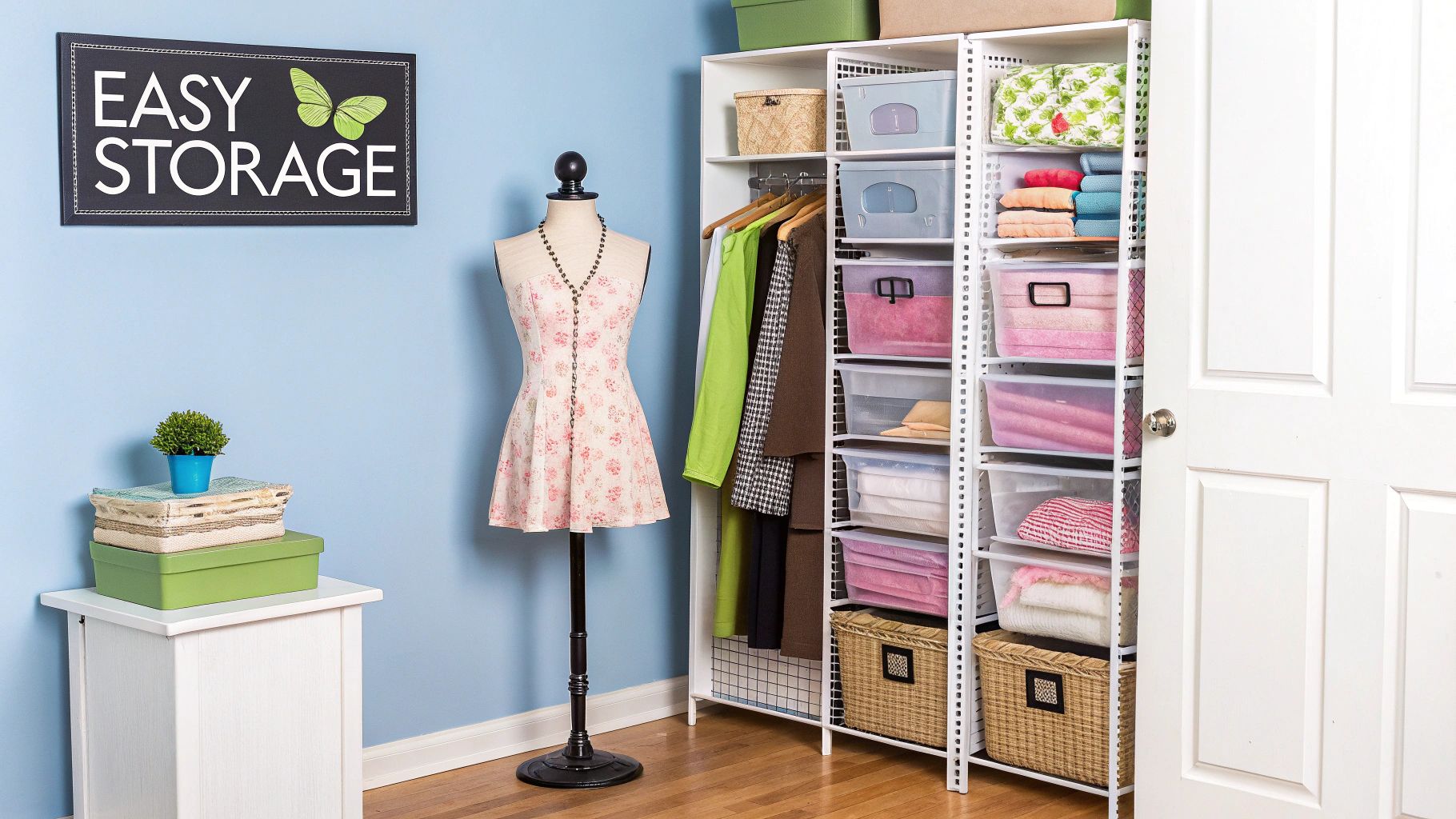
Like any brilliant tool, an adjustable dressmaking form has its own learning curve. Understanding the common pitfalls from the get-go can save you a mountain of frustration and ensure your form becomes a trusted sewing partner, not a source of stress. It’s all about using it correctly and confidently to get the best results.
One of the biggest mistakes I see is over-tightening the adjustment dials. It’s so tempting to just crank a dial all the way to hit a measurement, but this puts huge pressure on the internal gears. Over time, it can warp the form, creating an unnatural posture that will throw off the fit of every garment you make.
Another classic slip-up is buying the wrong size in the first place. Always remember that these forms only expand outwards from their base size. If your personal measurements are smaller than the form's minimum setting, you'll simply never be able to shrink it down enough for a true-to-you fit.
Key Adjustments and Fixes
Let's tackle these issues with some practical solutions. If you find your form has gone a bit lopsided from uneven adjustments, don't panic. Just reset all the dials back to their smallest setting. Then, start expanding them again, but do it gradually. Give each dial just a few turns at a time, moving around the form to build up a balanced, symmetrical shape.
To get a truly personalised fit, you can't rely on the dials alone. The real magic happens when you create a padded body double. This is where you use polyester wadding to build up areas that the standard form can't replicate, like:
- A rounded tummy or full abdomen
- The specific curve of a sway back
- Fuller hips or thighs
- Any asymmetries in the shoulders or bust
Pin the wadding securely in place, then pull a stretchy form cover over the top. This simple step smooths everything out, creating a single, cohesive shape that is a perfect blueprint of your unique body.
Don’t forget the back-waist length! This is a critical vertical measurement that dictates how a garment drapes across your torso. Get it wrong, and you’ll forever be battling fabric bunching at the waist or pulling at the shoulders. It’s often the hidden culprit behind ill-fitting bodices.
Long-Term Care and Maintenance
A little bit of upkeep will keep your dressmaking forms adjustable and working smoothly for years to come. Every so often, check that all the dials turn freely. To keep the fabric cover in good shape and prevent dust from getting into the mechanisms, give it a quick once-over with a gentle vacuum or a lint roller.
This focus on a custom fit mirrors a huge trend in the UK clothing industry. With retail sales soaring to an estimated £47.3 billion, social media is driving a massive demand for personalised clothing. Because adjustable forms make it easier to create made-to-measure garments, they help designers meet the expectations of shoppers—a crucial advantage when 67% of shoppers use social media to discover new brands. You can read more about the influential role of customisation in UK clothing retail on IBISWorld.com.
By sidestepping these common mistakes, you’ll be able to use your form with much more confidence. If you need a hand choosing the right model, take a look at our guide to the 7 best dress forms for sewing in the UK.
Your Dress Form Questions Answered
When you're ready to take your sewing to the next level, a few questions about adjustable dress forms always pop up. It's completely normal. Getting to grips with the finer points is what separates a good fit from a perfect one.
Think of this as your go-to reference for those common head-scratchers. We’ll cover the queries we hear most often, giving you clear, straightforward answers to help you use your form like a pro.
Can I Use a Dressmaking Form for Trousers?
Absolutely, but the type of form you have makes a huge difference. For the best results, you really need a model with either an offset centre pole or, even better, a bifurcated body—the kind with separate legs. This 'split leg' design is a game-changer for fitting trousers, shorts, and jumpsuits accurately.
On a standard form, you can check the fit around the waist and hips, but that's about it. You won't be able to see how the fabric hangs through the legs or properly assess crucial areas like the crotch depth and inseam. A bifurcated form gives you the full picture.
What Is the Best Way to Pad a Dress Form?
Padding a form to match your body is an art, but the technique is surprisingly simple. The most effective method is to use layers of polyester wadding held in place by a purpose-made, stretchy form cover. This combination lets you build up specific areas to mirror your unique shape.
First, take a good look at your own contours and see where they differ from the standard form. Common areas that need a bit of extra padding include the bust, the abdomen, or for a sway back.
Here's a simple process to follow:
- Layer and Pin: Cut pieces of wadding and pin them directly onto the form where you need more volume. Build it up gradually.
- Check Measurements: Keep your tape measure handy. As you add padding, constantly check the form's measurements against your own until they match up.
- Add the Cover: Once you're happy with the shape, pull a stretchy form cover over the entire torso. This neatly compresses the padding, smoothes out any lumps and bumps, and creates a single, pinnable surface to work on.
How Do I Choose the Right Size Adjustable Form?
This is easily the most important question of all. The answer is simple: always, always choose a form that can be adjusted down to your smallest measurements. Remember, an adjustable form can only get bigger from its starting size, never smaller.
If your own measurements are smaller than the form's minimum setting, you will never be able to get an accurate fit. It is far better to buy a form that's a touch smaller than you and pad it out to your exact size than to struggle with one that's too large from the outset.
Getting this one decision right will have the biggest impact on your dressmaking success. For a more detailed walkthrough, our article on how to buy a dress form you'll actually use is packed with practical advice.
Ready to find the perfect sewing partner? Explore the professional range of adjustable forms and display tools at Display Guru. https://www.displayguru.co.uk
